The Occupational Safety and Health Administration (OSHA) has an Occupational Chemical Database currently listing more than 800 hazardous chemicals used in U.S. workplaces. OSHA requires workplaces to keep safety data sheets (SDSs) for each of those hazardous chemicals. The SDS informs employees about the hazards of the chemical in their workplace, how to obtain information on the chemical, and what to do if a spill or accident occurs with that chemical.
Safety Data Sheets

Almost every chemical at your workplace should arrive with an SDS containing the hazards, handling, storage and disposal information associated with that chemical. The SDS will also contain exposure limits such as threshold limit values, permissible exposure limits and any other exposure limits recommended by the chemical manufacturer or importer.
SDSs also include the name of the manufacturer, physical properties, procedures for first aid, and the personal protective equipment, or PPE, recommended or required while using that chemical. If the material is a liquid, the SDS will contain information on spill control and spill prevention.
The sections of a chemical’s SDS include:
- Section 1: Identification includes the product identifier and the recommended use and restrictions, as well as the contact information and emergency phone number of the chemical manufacturer.
- Section 2: Hazard identification has the chemical’s classification under OSHA’s Hazard Communication (HAZCOM) Standard, as well as identifiers such as a signal word, hazard statements, symbols and precautionary statements. There may also be new hazards in this section that were discovered during the classification process.
- Section 3: Chemical composition lists the chemical name, any common names and synonyms, its Chemical Abstracts Service (CAS) number, and any impurities or stabilizing additives which are themselves classified and contribute to the classification of the substance. If the chemical is a mixture, this section will also contain the concentration, or the exact percentage, of all health hazards in that mixture. If a trade secret is claimed, the exact percentage of composition may be withheld from an SDS.
- Section 4: First aid measures will vary according to the method of exposure and the effects from being exposed to the chemical.
- Section 5: Fire-fighting measures lists all suitable and non-suitable extinguishing media, the nature of hazardous combustion products, as well as protective equipment to use and precautions for firefighters to take when trying to control the fire.
- Section 6: Accidental release measures explains the personal precautions, protective equipment and emergency procedures to implement should a release of the chemical occur, as well as methods to contain and clean up a spill.
- Section 7: Handling and storage instructions outlines safe handling and storage procedures and also lists other substances that are incompatible with the chemical.
- Section 8: Exposure limits and protective controls: Exposure limits on an SDS can include an OSHA permissible exposure limit (PEL) or an American Conference of Governmental Industrial Hygienists Threshold Limit Value (ACGIH TLV). Section eight also includes other recommended exposure limits as well as recommended controls and PPE.
- Section 9: Physical and chemical properties includes descriptions of how the chemical looks and smells, the boiling and melting temperatures, the chemical’s vapor pressure and evaporation rate, how easily it dissolves, and how heavy it is compared to water.
- Section 10: Stability and reactivity describes the possibility of hazardous reactions, incompatible materials, hazardous decomposition products and certain conditions to avoid. For instance, some chemicals can catch fire when exposed to just a little static electricity.
- Section 11: Toxicological information contains likely methods of exposure to the chemical, symptoms resulting from delayed and immediate exposures, and any measurements of toxicity. Section 11 will also indicate if the chemical is considered a carcinogen by OSHA, the National Toxicology Program or the International Agency for Research on Cancer.
- Section 12 (non-mandatory): Ecological information contains the chemical’s ecotoxicity, degradability, bioaccumulation potential, and its mobility in soil.
- Section 13 (non-mandatory): Disposal considerations provides guidance on proper disposal practices, recycling or reclamation of the chemical.
- Section 14 (non-mandatory): Transport information includes the UN number, the UN proper shipping name, any transport hazard classes, its packing group, environmental hazards such as being a marine pollutant, and any additional precautions to take when transporting in bulk.
- Section 15 (non-mandatory): Regulatory information identifies the specific safety, health and environmental regulations not listed elsewhere on the SDS.
- Section 16: Other Information includes the date the SDS was prepared or last modified.
Looking to explore more online courses?
VIEW THE 800+ COURSES AVAILABLE!
The SDS should be reviewed by each person that handles, stores or disposes of the chemical. One SDS may apply to multiple, complex mixtures having similar contents and hazards. An SDS must be available for each hazardous chemical in your workplace, and SDSs must be kept in a location where workers can access them as needed. If an SDS is lost or didn’t arrive at your facility with the chemical, you will need to contact the chemical’s manufacturer, importer or supplier to obtain additional copies.
GHS Pictograms
OSHA uses the Globally Harmonized System (GHS) to classify chemicals by their hazards. Each SDS contains one or more of the nine standard GHS pictograms, which appear as black images on a white background surrounded by red diamonds.
These GHS pictograms are as follows:
SDS Hazard Rating
Each chemical’s SDS contains one or more hazard ratings, which are numbers or letters indicating the type or severity of the hazard. For example, flammable liquids are categorized from one to four, with one being the most flammable and four the least flammable. Self-reactives and organic peroxides are categorized by type – A through G – with A being the least stable and G being the most stable. Acute toxicity is categorized from one to five, with one being most acutely toxic and five being relatively low acute toxicity.
Conclusion
Chemical exposure can lead to a variety of injuries and illnesses, ranging from burns and rashes to nervous system damage, organ damage and cancer. Understanding every part of a chemical’s SDS can help protect workers and work areas when working with, transporting or disposing of hazardous chemicals.



